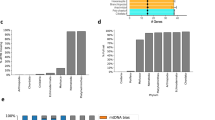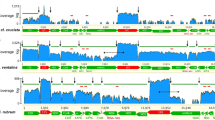Abstract
Most metazoans have two nuclear genes encoding orthologues of the well-characterized Saccharomyces cerevisiae mitochondrial transcription factor B (sc-mtTFB). This class of transcription factors is homologous to the bacterial KsgA family of rRNA methyltransferases, which in Escherichia coli dimethylates adjacent adenine residues in a stem-loop of the 16S rRNA. This posttranscriptional modification is conserved in most metazoan cytoplasmic and mitochondrial rRNAs. Homo sapiens mitochondrial transcription factor B1 (h-mtTFB1) possesses this enzymatic activity, implicating it as a dual-function protein involved in mitochondrial transcription and translation. Here we demonstrate that h-mtTFB2 also has rRNA methyltransferase activity but is a less efficient enzyme than h-mtTFB1. In contrast, sc-mtTFB has no detectable rRNA methyltransferase activity, correlating with the lack of the corresponding modification in the mitochondrial rRNA of budding yeast. Based on these results, and reports that Drosophila melanogaster mtTFB1 and mtTFB2 do not have completely overlapping functions, we propose a model for human mtDNA regulation that takes into account h-mtTFB1 and h-mtTFB2 likely having partially redundant transcription factor and rRNA methyltransferase functions. Finally, phylogenetic analyses of this family of proteins strongly suggest that the presence of two mtTFB homologues in metazoans is the result of a gene duplication event that occurred early in eukaryotic evolution prior to the divergence of fungi and metazoans. This model suggests that, after the gene duplication event, differential selective pressures on the rRNA methyltransferase and transcription factor activities of mtTFB genes occurred, with extreme cases culminating in the loss of one of the paralogous genes in certain species.





Similar content being viewed by others
References
Boore JL (1999) Animal mitochondrial genomes. Nucleic Acids Res 27:1767–1780
Burger G, Gray MW, Lang BF (2003) Mitochondrial genomes: anything goes. Trends Genet 19:709–716
Carrodeguas JA, Yun S, Shadel GS, Clayton DA, Bogenhagen DF (1996) Functional conservation of yeast mtTFB despite extensive sequence divergence. Gene Expr 6:219–230
Cermakian N, Ikeda TM, Cedergren R, Gray MW (1996) Sequences homologous to yeast mitochondrial and bacteriophage T3 and T7 RNA polymerases are widespread throughout the eukaryotic lineage. Nucleic Acids Res 24:648–654
Dairaghi DJ, Shadel GS, Clayton DA (1995) Addition of a 29 residue carboxyl-terminal tail converts a simple HMG box-containing protein into a transcriptional activator. J Mol Biol 249:11–28
Diffley JF, Stillman B (1991) A close relative of the nuclear, chromosomal high-mobility group protein HMG1 in yeast mitochondria. Proc Natl Acad Sci USA 88:7864–7868
Falkenberg M, Gaspari M, Rantanen A, Trifunovic A, Larsson NG, Gustafsson CM (2002) Mitochondrial transcription factors B1 and B2 activate transcription of human mtDNA. Nat Genet 31:289–294
Felsenstein J (2005) PHYLIP (Phylogeny Inference Package) version 3.65. Distributed by author, Department of Genome Sciences, University of Washington, Seattle; available at: http://evolution.genetics.washington.edu/phylip.html
Fisher RP, Clayton DA (1988) Purification and characterization of human mitochondrial transcription factor 1. Mol Cell Biol 8:3496–3509
Gleyzer N, Vercauteren K, Scarpulla RC (2005) Control of mitochondrial transcription specificity factors (TFB1M and TFB2M) by nuclear respiratory factors (NRF-1 and NRF-2) and PGC-1 family coactivators. Mol Cell Biol 25:1354–1366
Gray MW, Burger G, Lang BF (1999) Mitochondrial evolution. Science 283:1476–1481
Greenleaf AL, Kelly JL, Lehman IR (1986) Yeast RPO41 gene product is required for transcription and maintenance of the mitochondrial genome. Proc Natl Acad Sci USA 83:3391–3394
Hall T (2005) BioEdit version 7.05. Distributed by author, Carlsbad, CA; available at: http://www.mbio.ncsu.edu/BioEdit/bioedit.html
Helser TL, Davies JE, Dahlberg JE (1972) Mechanism of kasugamycin resistance in Escherichia coli. Nat New Biol 235:6–9
Jang SH, Jaehning JA (1991) The yeast mitochondrial RNA polymerase specificity factor, MTF1, is similar to bacterial sigma factors. J Biol Chem 266:22671–22677
Jones DT, Taylor WR, Thornton JM (1992) The rapid generation of mutation data matrices from protein sequences. Comput Appl Biosci 8:275–282
Klootwijk J, Klein I, Grivell LA (1975) Minimal post-transcriptional modification of yeast mitochondrial ribosomal RNA. J Mol Biol 97:337–350
Kumar S, Tamura K, Nei M (2004) MEGA3: Integrated software for Molecular Evolutionary Genetics Analysis and sequence alignment. Brief Bioinform 5:150–163
Lafontaine DL, Preiss T, Tollervey D (1998) Yeast 18S rRNA dimethylase Dim1p: a quality control mechanism in ribosome synthesis? Mol Cell Biol 18:2360–2370
Lang BF, Gray MW, Burger G (1999) Mitochondrial genome evolution and the origin of eukaryotes. Annu Rev Genet 33:351–397
Lisowsky T, Michaelis G (1988) A nuclear gene essential for mitochondrial replication suppresses a defect of mitochondrial transcription in Saccharomyces cerevisiae. Mol Gen Genet 214:218–223
Lisowsky T, Michaelis G (1989) Mutations in the genes for mitochondrial RNA polymerase and a second mitochondrial transcription factor of Saccharomyces cerevisiae. Mol Gen Genet 219:125–128
Masters BS, Stohl LL, Clayton DA (1987) Yeast mitochondrial RNA polymerase is homologous to those encoded by bacteriophages T3 and T7. Cell 51:89–99
Matsushima Y, Garesse R, Kaguni LS (2004) Drosophila mitochondrial transcription factor B2 regulates mitochondrial DNA copy number and transcription in schneider cells. J Biol Chem 279:26900–26905
Matsushima Y, Adan C, Garesse R, Kaguni LS (2005) Drosophila mitochondrial transcription factor B1 modulates mitochondrial translation but not transcription or DNA copy number in Schneider cells. J Biol Chem 280:16815–16820
McCulloch V, Shadel GS (2003) Human mitochondrial transcription factor B1 interacts with the C-terminal activation region of h-mtTFA and stimulates transcription independently of its RNA methyltransferase activity. Mol Cell Biol 23:5816–5824
McCulloch V, Seidel-Rogol BL, Shadel GS (2002) A human mitochondrial transcription factor is related to RNA adenine methyltransferases and binds S-adenosylmethionine. Mol Cell Biol 22:1116–1125
O’Farrell HC, Scarsdale JN, Rife JP (2004) Crystal structure of KsgA, a universally conserved rRNA adenine dimethyltransferase in Escherichia coli. J Mol Biol 339:337–353
Page RD (1996) TreeView: an application to display phylogenetic trees on personal computers. Comput Appl Biosci 12:357–358
Parisi MA, Clayton DA (1991) Similarity of human mitochondrial transcription factor 1 to high mobility group proteins. Science 252:965–969
Rantanen A, Gaspari M, Falkenberg M, Gustafsson CM, Larsson NG (2003) Characterization of the mouse genes for mitochondrial transcription factors B1 and B2. Mammal Genome 14:1–6
Schinkel AH, Koerkamp MJ, Touw EP, Tabak HF (1987) Specificity factor of yeast mitochondrial RNA polymerase. Purification and interaction with core RNA polymerase. J Biol Chem 262:12785–12791
Schmidt HA, Strimmer K, Vingron M, von Haeseler A (2002) TREE-PUZZLE: maximum likelihood phylogenetic analysis using quartets and parallel computing. Bioinformatics 18:502–504
Schubot FD, Chen CJ, Rose JP, Dailey TA, Dailey HA, Wang BC (2001) Crystal structure of the transcription factor sc-mtTFB offers insights into mitochondrial transcription. Protein Sci 10:1980–1988
Seidel-Rogol BL, McCulloch V, Shadel GS (2003) Human mitochondrial transcription factor B1 methylates ribosomal RNA at a conserved stem-loop. Nat Genet 33:23–24
Shadel GS (2004) Coupling the mitochondrial transcription machinery to human disease. Trends Genet 20:513–519
Shadel GS, Clayton DA (1995) A Saccharomyces cerevisiae mitochondrial transcription factor, sc-mtTFB, shares features with sigma factors but is functionally distinct. Mol Cell Biol 15:2101–2108
Shutt TE, Gray MW (2006) Homologs of mitochondrial transcription factor B, sparsely distributed within the eukaryotic radiation, are likely derived from the dimethlyadenosine methyltransferase of the mitochondrial endosymbiont. Mol Biol Evol 23:1169–1179
Thompson JD, Gibson TJ, Plewniak F, Jeanmougin F, Higgins DG (1997) The CLUSTAL_X windows interface: flexible strategies for multiple sequence alignment aided by quality analysis tools. Nucleic Acids Res 25:4876–4882
van Buul CP, van Knippenberg PH (1985) Nucleotide sequence of the ksgA gene of Escherichia coli: comparison of methyltransferases effecting dimethylation of adenosine in ribosomal RNA. Gene 38:65–72
Vila-Sanjurjo A, Squires CL, Dahlberg AE (1999) Isolation of kasugamycin resistant mutants in the 16 S ribosomal RNA of Escherichia coli. J Mol Biol 293:1–8
Xu B, Clayton DA (1992) Assignment of a yeast protein necessary for mitochondrial transcription initiation. Nucleic Acids Res 20:1053–1059
Acknowledgments
This work was supported by NIH Grant HL-59655 from the National Heart, Lung and Blood Institute awarded to G.S.S. The authors wish to thank Dr. A. Vila-Sanjurjo for providing the E. coli ksgA mutant strain used in this study and Nick Bonawitz and Tim Shutt for providing critical insights and comments on the manuscript.
Author information
Authors and Affiliations
Corresponding author
Additional information
[Reviewing Editor: Dr. Martin Kreitman]
Electronic Supplementary Material
Rights and permissions
About this article
Cite this article
Cotney, J., Shadel, G.S. Evidence for an Early Gene Duplication Event in the Evolution of the Mitochondrial Transcription Factor B Family and Maintenance of rRNA Methyltransferase Activity in Human mtTFB1 and mtTFB2. J Mol Evol 63, 707–717 (2006). https://doi.org/10.1007/s00239-006-0075-1
Received:
Accepted:
Published:
Issue Date:
DOI: https://doi.org/10.1007/s00239-006-0075-1




